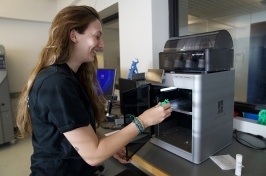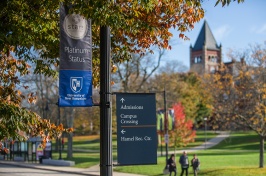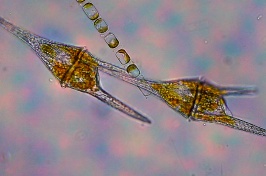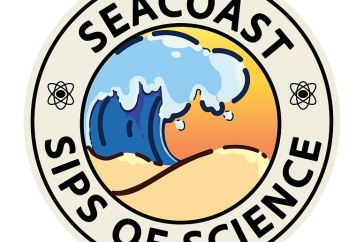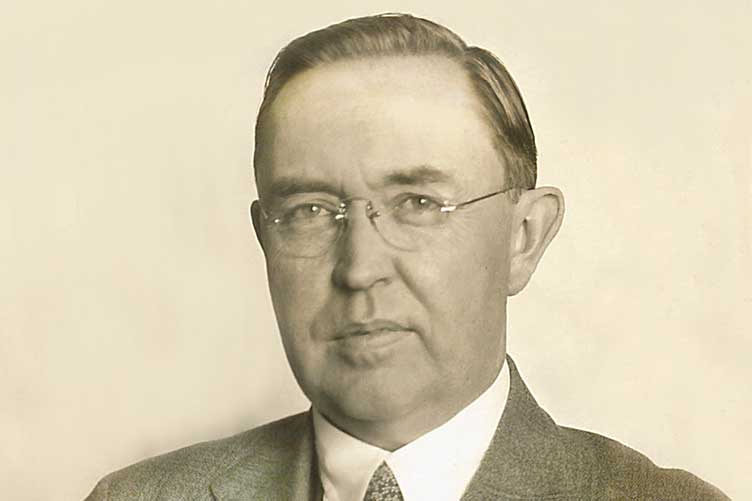
Floyd Jackson could do just about anything. Skin a mouse with surgical precision, make wine, explore the northern wilderness by dog sled, change lives. He started by remaking his own: having come to UNH from the Midwest as a landlocked specialist on "plant lice," or aphids, he became an expert on marine life, geology, and zoology—an ecologist even before the word had been invented.
For decades, on a campus of professors, a reference to "Prof" meant just one man. Teacher, chair of the UNH Biological Institute, dean of the College of Liberal Arts—Jackson inspired generations of students, and the marine science lab he founded in 1928 on the Isles of Shoals remains a special learning environment today. But Jackson's legacy extends well beyond the marine science community; everyone in the Seacoast entranced by the special beauty of Great Bay, Little Bay, and the mighty Piscataqua River is in debt to Floyd Jackson, who promoted stewardship of the estuary long before such caring was fashionable. Ironically, he also advocated its development. And with the Piscataqua's health and future once again in the news, the story of the UNH biologist who began to investigate this enchanting ecosystem a century ago reveals a defining paradox: how attention to the conservation of marine resources has long co-existed with actions that degrade them.
Christened Cicero Floyd, Jackson was born in White County, Indiana, in 1883. His career in zoology began with childhood afternoons spent catching frogs and other small animals, and by high school he'd been sufficiently bitten by the biology bug to purchase his first microscope. That would have been around 1900, when the best and brightest minds in American biology were utilitarians, striving to understand organisms so as to better exploit or restrain them.
Jackson believed that biology contributed to the promise of American life, and that nature should benefit society. After graduating with a master's degree from Ohio State University, where he taught histology and embryology, he landed a job in 1908 as assistant entomologist at the New Hampshire College of Agriculture and the Mechanic Arts, thanks in large part to his Midwestern aphid work. The turning point in his career came several years later, in 1913 or 1914, shortly after the publication of his textbook, Elementary Entymology. Floyd Jackson got access to a boat.
The Oyster River flowed south near the muddy unfinished campus that had been Ben Thompson's farm, over the fall-line at Newmarket Road and toward the inviting expanse of the Little Bay and Great Bay estuary. Much of the mud flats between the Bellamy River and Broad Cove were densely covered with eelgrass, ideal habitat for eels, minnows, sticklebacks, and small flounder, and while surveying vertebrate distribution, Jackson became enchanted with the bay and the rich marine life living there. His "Ecological Features of Great Bay, New Hampshire," published in 1922, became the first scientific study of the estuary ever produced, its findings a record of how much we have lost.
"Opposite the mouth of the Oyster River," Jackson noted, was a strip of hard sand in about 30 feet of water known as the "Cod Grounds," where in early spring and late fall one could find "a considerable school of codfish ranging in weight from six to fifteen pounds," in addition to large cunners, sculpin, flounders, and the occasional skate. Today, of course, such fish would swim there only in anglers' dreams, but significant human impacts already had occurred by the time Jackson assessed the Great Bay ecosystem in 1915. "Considerable sewage" he noted, was being "poured either directly or indirectly into the waters" by surrounding towns, and many species of fish, once indigenous to the system, had already disappeared thanks to human activities—Atlantic salmon, common sturgeon, shad, mackerel, bluefish, and striped bass.

Jackson set his sights on the Isles of
Shoals after he acquired a gasoline-
powered launch he named
Shankhassick, the Native American
term for the Oyster River.
Great Bay whetted Jackson's appetite for studying larger marine systems and he soon purchased a gasoline-powered launch capable of operating in coastal waters. Naming the boat Shankhassick, the Native American term for the Oyster River, he set his sights on the Isles of Shoals. There, he thought, "every marine condition imaginable" would be within easy access for students. "The islands themselves," he wrote, "although bleak and barren, hold a charm which is very difficult to explain."
Jackson's Marine Zoological Laboratory made its debut in the summer of 1928, operating out of a handful of buildings on Appledore—the largest island—that had been abandoned when the Appledore Hotel burned. The logistics were daunting: everything for the colony of 50-60 people had to be carried in and out by boat, buildings had to be reconditioned and a wharf constructed, and it was so cold that the 14 hardy students who had signed on that first year burned everything in sight—including renowned 19th century poet Celia Thaxter's garden gate. Enrollments grew steadily, however, and by the eleventh season Jackson was justifiably proud that his program had "produced a proportionally large number of biological celebrities" who went on to medical school or became research scientists.
Prof's infatuation with oceanography and the Shoals did not prevent him from pursuing other scientific interests. A self-styled biological explorer committed to field work, he made regular "collecting trips" for specimens. August 1931 found him at Cape Breton, Nova Scotia. A few months later, Prof canoed through North Carolina's cypress swamps, wearing his signature fedora hat. At the tail end of the summer of 1932 he explored the north shore of the Gulf of St. Lawrence, including southern Labrador. Ultimately he made 15 trips there. Using his canoe in summer and his sled and Siberian Huskies in winter, Prof discovered—among other things—a new subspecies of deer mice. His grueling winter expeditions, whether in northern New Hampshire or Labrador, always depended on the capable sled dogs raised at his home near Jackson's Landing, in Durham. He loved those dogs.
In 1942, World War II shuttered Jackson's beloved Shoals laboratory, which wouldn't reopen until Cornell professor John Kingsbury hosted a two-week undergraduate marine biology program there almost 30 years later. But the setback did not diminish Prof's commitment to marine science or his interest in the bay. Despite numerous impediments, including gasoline rationing and the induction of one after another of his researchers into the armed forces, he spent the war years researching and writing "A Biological Survey of Great Bay New Hampshire." It was a curious document. On the one hand, it was pure science, with measurements of pH, nitrates, turbidity, and "over 4,000 separate bacteriological cultures" that quantified dreadful fecal contamination in the estuary. At the same time, however, it was a promotional piece, enthusing that "the Great Bay area offers ideal post-war projects." One section went so far as to lay out the best locations for summer cottages.

Jackson believed that improvement of the bay hinged on several factors. Proper sewage disposal came first. After that, remedying fishes' access to breeding grounds was important, as was his hope that his Biological Institute would be able to find "disease-resisting strains of eel-grass" to combat the wasting disease that ravaged beds during the 1930s—and that, unfortunately, continues to this day.
He retired from teaching in 1952, but Jackson never stopped researching, writing, or messing about in boats. Each spring he and his boating buddies, William L. Prince II '30 and George Frick, an emeritus natural resources professor known as Curly, set the channel marker poles in the Oyster River. Prof always wore a necktie.
Jackson died in 1970 at the age of 87. Several months after his death, UNH dedicated the Jackson Estuarine Laboratory at Adams Point, inviting Eugene P. Odum, the most respected ecologist in the nation, to deliver the dedication address. The choice was at once fitting and ironic: Odum's path-breaking textbook Fundamentals of Ecology appeared in 1953—just after Jackson's retirement. The book profoundly influenced the next generation of biologists, emphasizing the conservation and zoological interconnectedness with which Jackson had experimented, while eclipsing the purely utilitarian approaches on which Prof had been raised, and which he never entirely shook.
Prof was of a different generation. He wrote about New Hampshire's stunning estuary and coastal ocean for nearly 50 years with a curious amalgam of inquiry, developmental enthusiasm, and conservation, documenting human impacts such as the heavy pollution of Exeter's Squamscott River with an unsparing eye. As his heirs, we do well to remember that Jackson's legacy is not only his passion and inspiration, but his understanding that the ecosystem through which he defined himself—and whose restoration he sought—remains vulnerable to the often unwitting actions of those who lean too heavily upon it. ~
Jeff Bolster is a professor of history at UNH. His most recent book, The Mortal Sea: Fishing the Atlantic in the Age of Sail (2012), won four awards, including the Bancroft Prize.
Originally published by:
UNH Magazine, Spring 2014 Issue
-
Written By:
Jeff Bolster | freelance writer















